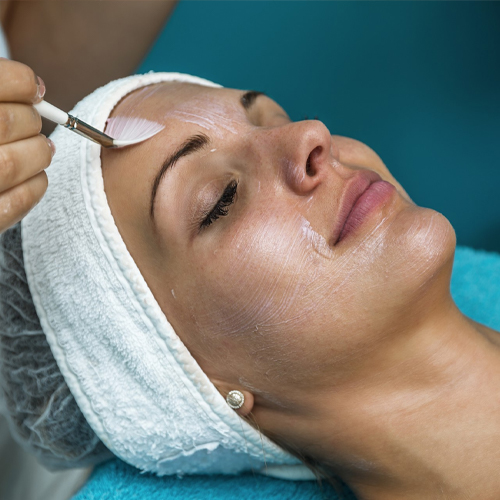Chemical peels are a popular cosmetic treatment designed to improve the appearance of the skin by removing damaged outer layers and encouraging the growth of new, healthier skin. They can address various skin concerns, including acne, pigmentation, and signs of aging. This guide explores what chemical peels are, the different types available, their benefits, and what to expect from the treatment.
What is a Chemical Peel?
A chemical peel involves applying a chemical solution to the skin to exfoliate and remove the outer layers. This process promotes the shedding of damaged skin cells and stimulates the regeneration of new skin, resulting in a smoother, more youthful complexion.
Types of Chemical Peels
Chemical peels vary in strength and depth, depending on the type of chemical solution used and the treatment goals. The three main types of chemical peels are:
-
Superficial Peels
- Ingredients: Often contain mild acids like alpha hydroxy acids (AHAs), such as glycolic or lactic acid.
- Depth: Targets the outermost layer of the skin (epidermis).
- Uses: Suitable for improving skin texture, tone, and brightness. Commonly used for mild acne, superficial pigmentation, and fine lines.
- Recovery: Minimal downtime, with possible mild redness or peeling. Results are usually seen after a series of treatments.
-
Medium Peels
- Ingredients: Typically contain trichloroacetic acid (TCA) or a combination of AHAs and TCA.
- Depth: Penetrates the epidermis and the upper layers of the dermis.
- Uses: Effective for treating moderate skin issues, such as deeper wrinkles, moderate pigmentation, and acne scars.
- Recovery: Downtime of about 1-2 weeks, with redness, peeling, and potential scabbing. Improved results are often visible after a single treatment.
-
Deep Peels
- Ingredients: Usually involve phenol or high concentrations of TCA.
- Depth: Reaches deeper layers of the dermis.
- Uses: Best for addressing severe skin issues, such as deep wrinkles, significant pigmentation, and extensive sun damage.
- Recovery: Requires significant downtime of 2-3 weeks or more. Redness, peeling, and swelling are common, with more pronounced results seen after recovery.
How Does a Chemical Peel Work?
-
Consultation: The process begins with a consultation to discuss your skin concerns, goals, and medical history. Your practitioner will recommend the most suitable type of peel based on your needs.
-
Preparation: The skin is cleansed and prepped for the peel. This may involve discontinuing certain skincare products or medications to reduce the risk of complications.
-
Application: The chemical solution is applied to the skin, and the treatment time varies depending on the type of peel. The solution is left on for a specific period to achieve the desired level of exfoliation.
-
Neutralization and Removal: After the appropriate time, the chemical solution is neutralized and removed. The skin is then cleansed, and any post-peel products or treatments are applied.
-
Aftercare: Post-treatment care is essential to promote healing and achieve optimal results. This may include using gentle skincare products, avoiding sun exposure, and following any specific instructions provided by your practitioner.
Benefits of Chemical Peels
- Improved Skin Texture: Enhances the smoothness and softness of the skin by removing damaged outer layers.
- Brighter Skin Tone: Addresses uneven pigmentation, age spots, and dullness, leading to a more radiant complexion.
- Reduction of Wrinkles: Minimizes the appearance of fine lines and wrinkles, particularly with medium and deep peels.
- Acne Treatment: Helps to unclog pores and reduce acne breakouts, especially with superficial and medium peels.
- Scar Improvement: Can improve the appearance of acne scars and other superficial scars over time.
What to Expect Before, During, and After a Chemical Peel
-
Before the Treatment
- Consultation: Discuss your skin concerns and treatment goals with your practitioner. They will assess your skin type and recommend the most suitable peel.
- Preparation: Follow any pre-treatment instructions, such as avoiding certain skincare products or medications.
-
During the Treatment
- Application: The chemical solution is applied to your skin, and you may experience a stinging or burning sensation, depending on the type of peel.
-
After the Treatment
- Recovery: Your skin may be red, sensitive, and prone to peeling or flaking. Follow the aftercare instructions provided, which may include avoiding sun exposure and using specific skincare products.
- Results: Improved skin texture and tone will become more noticeable as the skin heals. The full benefits may take several weeks to be fully apparent.
Considerations and Risks
- Skin Sensitivity: Chemical peels can cause temporary redness, peeling, and sensitivity. Choose a reputable practitioner to minimize risks and ensure safe application.
- Sun Protection: After a peel, your skin will be more sensitive to sun exposure. Use sunscreen diligently to protect your skin and prevent further damage.
- Consultation: Always consult with a qualified practitioner to determine the appropriate type of peel and to ensure that the treatment is suitable for your skin type and concerns.


